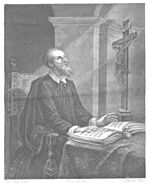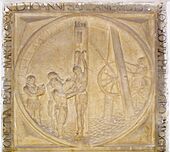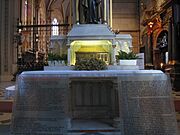Jan Sarkander facts for kids
Quick facts for kids SaintJan Sarkander |
|
|---|---|

Sketch from 1855
|
|
| Martyr | |
| Born | 20 December 1576 Skoczów, Silesia, Crown of Bohemia (now Poland) |
| Died | 17 March 1620 (aged 43) Olomouc, Moravia, Crown of Bohemia (now the Czech Republic) |
| Venerated in | Roman Catholic Church |
| Beatified | 6 May 1860, Saint Peter's Basilica by Pope Pius IX |
| Canonized | 21 May 1995, Olomouc, Czech Republic by Pope John Paul II |
| Feast | 17 March |
Jan Sarkander (in Czech and Polish: Jan Sarkander) was a Catholic priest. He was born on December 20, 1576, and died on March 17, 1620.
Jan Sarkander was first married. After his wife passed away, he decided to become a priest. He was very active in defending the Catholic faith. This was a time when many people were against Catholics.
He was arrested because of false accusations. He was tortured for about a month but refused to give in. He died from his injuries.
Later, Pope Pius IX declared him "Blessed" in 1860. In 1995, Pope John Paul II made him a saint. This happened during the Pope's visit to the Czech Republic.
Contents
Life of Jan Sarkander
Jan Sarkander was born on December 20, 1576. His hometown was Skoczów, which is now in Poland. His parents were Georg Mathias Sarkander and Helene Górecka.
He had one sister and three brothers. One of his brothers, Nicholas, also became a priest. When Jan's father died in 1589, his family moved to Příbor. His mother remarried and had another son.
Jan first thought about becoming a priest. But then he changed his mind and got married. He and his wife lived in Brno. Sadly, his wife died just one year later. They did not have any children. After this, Jan decided to study for the priesthood. He felt that God was calling him to this path.
His Education and Priesthood
Jan Sarkander studied at the Olomouc college from 1597 to 1600. He had to move to Charles University in Prague because of the plague. In 1603, he earned his master's degree in philosophy from Prague.
He continued his studies in theology in Austria starting in 1604. He also studied at the University of Graz. He passed his final exams on December 21, 1607. He became a sub-deacon in December 1608. Then, he became a deacon in March 1609.
On December 22, 1607, he received minor orders from Cardinal Franz von Dietrichstein. The bishop of Olomouc, Jan Křtitel Civalli, made him a priest on March 22, 1609, in Graz.
Work as a Priest
Sarkander first worked as a parish priest in Boskowitz. In 1616, he was sent to Holešov. Baron von Lobkowitz, a powerful person from Moravia, supported Jan's work. However, a rich landowner named Bitowsky von Bistritz was against Catholics. He even wanted Sarkander killed.
The Thirty Years War started in 1618. This was a big conflict between Protestants and Catholics. Because of the war, Jan had to flee to Poland for a short time in May 1619. He visited a holy place called the Shrine of Our Lady of Czestochowa. He also spent time with a religious group called the Minims. After a few months, he returned home.
In February 1620, Polish soldiers came through Moravia. They were helping the emperor. These soldiers caused a lot of damage to Protestant lands. But they spared Holleschau (Holešov) when Jan met them. He carried the Blessed Sacrament, which is very important to Catholics.
The Jesuits, another religious group, helped Jan. They helped 200 non-Catholics become Catholic. But other non-Catholics were very angry about this.
Arrest and Death
During the Bohemian Revolt, Protestant leaders accused Jan Sarkander of working with Baron von Lobkowitz. They said he helped bring enemy soldiers into the area. So, Jan was arrested and taken to Olmütz (Olomouc). There, he was tortured.
They questioned him about who called the soldiers. They also asked about his dealings in Poland. Most importantly, they wanted to know what Baron von Lobkowitz told him in confession. Jan refused to tell them what was said in confession. This is because priests must keep confessions secret.
He was tortured on February 13, and again on the 17th and 18th. This went on for up to three hours each time. They used lit candles on him. They also put oil, pitch, and sulfur on his body and set it on fire. He suffered for a month in prison. He died from his injuries on March 17, 1620.
Becoming a Saint
The process to make Jan Sarkander a saint began under Pope Benedict XIV. But it stopped for a while. Then, Pope Pius IX officially recognized that Jan was killed "in hatred of the faith" in 1859. This means he died because of his strong belief. Pope Pius IX then declared him "Blessed" on May 6, 1860. He is recognized as a Martyr.
Pope John Paul II approved a miracle that happened because people prayed to Jan Sarkander. This happened on April 2, 1993. Then, Pope John Paul II made him a saint on May 21, 1995. This was during the Pope's visit to the Czech Republic.
Today, parts of Jan Sarkander's body, called relics, are kept in Saint Wenceslas Cathedral in Olomouc, Czech Republic.
There is also a special chapel built for him. It stands on Michael's Hill, where the prison used to be. The original torture rack and Jan Sarkander's gravestone are kept there.
See also
 In Spanish: Juan Sarkander para niños
In Spanish: Juan Sarkander para niños



